#Powertrains
Note
2, 7, 19!
2. Is there a driver you like more now than you did at the beginning of the season?
tbh i was unfortunately mostly a hater season so in the strict sense probably not. unless i cheat and say lewis bc watching him this year was genuinely something special. but more in the spirit of the question, and promise this is not pandering, but it probably is fernando alonso. not because i actually like him per se, but he is extremely entertaining and he kicked off one of THE best days on here with that aston martin move. he occasionally fills me with white hot rage that only red bull can exceed but there's no denying that formula one is more interesting with him around.
7. After watching them for a whole season, what do you think were the prettiest and ugliest car?
ferrari the prettiest, especially that wing they had for monza, phew. i can't look past the w13 for the ugliest i hope to never see that fucking car again in my life.
19. Best duo on the grid the season (romantic or platonic).
yuki and pierre. i still don't know what the hell is going on there but i certainly enjoyed watching it.
4 notes
·
View notes
Note
1. what is your favourite food/beverage to make/reach for when you're feeling cold and weary?
2. how do you think you learn new things best?
3. what's the longest thing you've written (art or academic) and do you intend on beating that record?
one: i gave this a long hard think. like when my soul is truly downtrodden and i feel so sad and small and exhausted and it's the dead of chicago winter, i'll make golden lentil soup with basmati rice in it and it's so nourishing. peak comfort.
two: kinetically, for sure. if i can pair something with a motion i will retain it much better. that's why i don't retain information very well when i'm just sitting still only looking/listening.
three: longest thing i've ever written for pleasure was 31654 words. i know i wrote academic things longer than that but they were many hard drives ago and i couldn't tell you exactly :( i would love to write a novel someday so yes i think intend to beat that. let's hope!
#such good questions thank you rhu ♥♥♥#powertrains#ask#meme#i think the longest thing i ever wrote was for a forum class and it was about connecting tumblr with death of the author#the essay had to become an hour-long presentation which was my worst nightmare#then my professor liked my presentation so much she asked me to do it at a conference and i said no#still wonder what might have happened if i had said yes!
3 notes
·
View notes
Text
Internal Combustion Engine
March 5, 2024
by dorleco
with no comment
Autonomous Vehicle Technology
Edit

Introduction
In the United States, internal combustion engines power almost 250 million highway vehicles due to their exceptional longevity and drivability. They can run on renewable or alternative fuels in addition to gasoline or diesel (e.g., natural gas, propane, biodiesel, or ethanol). Additionally, they can be paired with plug-in hybrid electric systems to increase the range of hybrid electric vehicles or with hybrid electric powertrains to improve fuel efficiency.
Internal combustion engines are divided into two groups:
Continuous combustion:
Engines with both intermittent and continuous combustion. Fuel and oxidizer enter the engine steadily, which is the hallmark of a continuous-combustion engine. An engine (such as a jet engine) maintains a steady flame.
Intermittent-combustion engines:
The air and fuel in an intermittent combustion engine ignite periodically, giving rise to the term “reciprocating engine.” A cycle is used to process discrete amounts of fuel and air. Examples of this second type are diesel engines and gasoline piston engines.
A sequence of thermodynamic events can be used to describe internal combustion engines. Thermodynamic processes take place concurrently in a continuous-combustion engine as the fuel, oxidizer, and combustion products move through the engine in a steady flow.
In contrast, all of the events in an intermittent combustion engine happen one after the other and are repeated throughout each cycle.
Internal combustion engines consume air, compress it, and either introduce fuel into the air or compress the air-fuel combination. Rockets are an exception to this rule, as they use both liquid-propellant and solid rocket motors.
The air-fuel mixture is then burned, work is obtained from the expansion of the hot gaseous combustion products, and finally, the combustion products are discharged through the exhaust system, as is the case with all internal combustion engines.
Their functioning can be compared to that of external combustion engines (such as steam engines), where energy is obtained exclusively by heat transfer to the working fluid via a heat exchanger and no chemical reaction occurs in the working fluid.
The four-stroke, gasoline-powered, homogeneous-charge, spark-ignition engine is the most widely used internal combustion engine. This might be attributed to its exceptional performance as a leading player in the ground transportation sector.

The aeronautics industry uses spark-ignition engines as well, but because of its focus on range, speed, and passenger comfort, aircraft gas turbines have emerged as the industry’s main players.
Exotic systems including advanced rocket engines and motors, like those found on U.S. space shuttles and other spacecraft, and supersonic combustion ramjet engines (scramjets), like those envisioned for hypersonic aircraft, are also included in the category of internal combustion engines.
How Does An Internal Combustion Engine Work?
The fundamental chemical process of releasing energy from a fuel and air mixture is called combustion, or burning. The process of fuel ignition and combustion in an internal combustion engine (ICE) takes place inside the engine. After that, the engine uses a portion of the energy produced by combustion to power itself. A stationary cylinder and a moving piston make up the engine. The crankshaft rotates as a result of the piston being pushed by the expanding combustion gasses. In the end, this action turns the wheels of the car through a set of gears in the powertrain.
The spark-ignition gasoline engine and the compression-ignition diesel engine are the two types of internal combustion engines that are currently in production. The majority of these are four-stroke engines, which require four piston strokes to complete a cycle. The intake, compression, combustion, power stroke, and exhaust are the four independent operations that make up the cycle.
The methods used by compression ignition diesel engines and spark ignition gasoline engines to feed and ignite fuel are different. During the intake phase in a spark ignition engine, fuel and air are combined and then forced into the cylinder. The fuel-air mixture is compressed by the piston and then ignited by the spark, leading to combustion. During the power stroke, the piston is pushed by the combustion gasses’ expansion. Only air is introduced and subsequently compressed into an engine in a diesel. The fuel then ignites when diesel engines spray it into the hot compressed air at a proper, controlled rate.
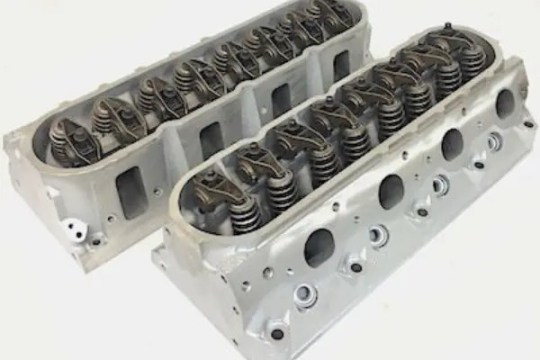
In essence, an internal combustion engine converts the air-fuel mixture’s heat energy into mechanical energy. The reason it is named Four Strokes is that a full combustion cycle in the piston requires four strokes to complete. An internal combustion engine, sometimes known as an ICE (internal combustion engine), is a four-stroke piston engine that powers a passenger car.
Let’s now investigate which constitutes an ICE’s principal parts.
The camshaft(s), valves, valve buckets, valve return springs, spark/glow plugs, and injectors (for direct injection engines) are typically located in the cylinder head. The engine’s cooling liquid passes via the cylinder head.
We can locate the piston, connecting rod, and crankshaft inside the engine block. Regarding the cylinder head, coolant passes through the engine block to assist in regulating the engine’s temperature.
From BDC to TDC, the piston travels inside the cylinder. When the piston is near TDC, a volume is formed between the cylinder head, engine block, and piston. This space is known as the combustion chamber.
An ICE with four strokes has the following phases (strokes) in a complete engine cycle:
Intake power (expansion) exhaust compression intake The piston’s movement between the bottom and top dead centers is referred to as a stroke.
Now that we are aware of an ICE’s constituent parts, we can investigate the actions that take place throughout each engine cycle stroke. The position of the piston at the start of each stroke and the specifics of what happens inside the cylinder are displayed in the table below.
Stroke 1 – INTAKE

Stroke 2 – COMPRESSION
After the intake stroke is complete, the piston begins the compression stroke at BDC. The intake and exhaust valves close during the compression stroke, and the piston travels toward TDC. The air/mixture is compressed when both valves are closed, and when the piston approaches TDC, the pressure reaches its maximum.
During the compression stroke, just before the piston reaches TDC (but not quite there),
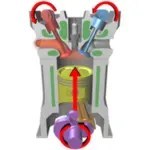
Stroke 3 – POWER

Stroke 4 – EXHAUST
After the power stroke is over, the exhaust stroke begins with the piston at the BDC. There is an open exhaust valve during this stroke. Most of the exhaust gasses are forced out of the cylinder and into the exhaust pipes by the piston’s movement from the BDC to the TDC.
The engine uses energy during the exhaust stroke because the components’ inertia causes the crankshaft to rotate.
As you can see, the piston needs to make four strokes to complete a combustion (engine) cycle. This indicates that two full crankshaft revolutions (720°) are required for one engine cycle.

Advantages of internal combustion engines
Engine size is extremely small in comparison to external combustion engines.
The power-to-weight ratio is elevated.
Excellent for applications with low power requirements
Typically, more transportable than external combustion engines of the same kind
safer to use with a much shorter start time
Higher efficiency compared to an external combustion engine
There is no possibility of working fluid leaks
minimal upkeep is necessary
Compared to external combustion engines, there is a reduction in lubricant use.
Because the peak temperature is only achieved briefly (during the fuel’s explosion), the overall working temperature in the case of reciprocating internal combustion is modest.
Disadvantages of internal combustion engines
The range of fuels available for utilization is restricted to extremely high-quality gaseous and liquid fuels.
Fuel utilized, such as gasoline or diesel, is quite expensive.
In general, engine emissions are higher than those of an external combustion engine.
Unsuitable for producing significant amounts of power
When there is reciprocating internal combustion, fuel detonation produces noise.
Types and applications of internal combustion engine:
Gasoline engines are utilized in automobiles, boats, and airplanes.
Gas engines are employed to provide industrial power.
Diesel engines are utilized in the automotive, railroad, power, and marine industries.
Gas turbines: They are employed in the maritime, industrial, and aircraft industries.
Conclusion:
To sum up, for more than a century, internal combustion engines have been essential in powering a variety of industry and transportation options. They are essential to contemporary industrialization and mobility because of their effectiveness, dependability, and flexibility. However, the desire to switch to greener, more sustainable options is growing as worries about the effects on the environment and the depletion of resources increase.
Internal combustion engines’ dependence on fossil fuels is still a severe disadvantage, despite notable improvements in efficiency and emissions reduction. Research and development efforts are being directed toward alternative fuels like biofuels and hydrogen, as well as electrification technologies like electric and hybrid powertrains, in an attempt to address these problems.
Moreover, the use of sophisticated engine management systems, lightweight materials, and enhanced aerodynamics keeps improving internal combustion engine performance and fuel efficiency. To combat climate change and lessen reliance on limited resources, a thorough transition to greener transportation options is required.
In conclusion, even though internal combustion engines have proved essential to contemporary transportation and industry, there are growing concerns about their long-term viability. The key to the future is adopting cutting-edge technologies that balance environmental protection with the changing demands of society for dependable and efficient power sources.
Also Read: Things to know about Hybrid Powertrains
#InternalCombustionEngine#VCU#Powertrains#EVEMS#EVCharging#Dorleco#ADAS#Electricmotor#EVs#Hybridelectricvehicles#Electrigenerator
0 notes
Text
Revolution on Wheels: 2024 Hyundai Ioniq 6 and Kia EV9 Review
The streamlined design considering aerodynamic coefficient, aesthetic beauty, and functional efficiency.
New Standards for SUV EV Design in the New Mobility Era
The future of driving has arrived, and it’s wearing a German badge with Korean flair. In 2024, Hyundai and Kia have teamed up to unleash a dynamic duo of electric vehicles, the Hyundai Ioniq 6 and the Kia EV9, onto the world stage.…

View On WordPress
#carbon footprint#german badge#infotainment system#instant torque#ionic6#kia ev9#korean flair#powertrains
0 notes
Text


bro has no chill, Max is a menace; also, why did you have to cut your hair max 😔
#f1#formula 1#formula one#red bull racing#red bull#max verstappen#redbull racing#red bull honda#red bull f1#red bull team#red bull formula 1#red bull powertrains#redbull f1#japanese gp#japanese gp 2024#japanese grand prix#japan gp 2024#japan grand prix
257 notes
·
View notes
Text



max loves his husband ❤️
#f1#formula 1#formula one#max verstappen#red bull f1#red bull honda#red bull racing#red bull team#red bull powertrains#checo perez#sergio pérez#sergio checo pérez#sergio perez#japanese gp 2024#japanese gp#japanese grand prix#japan gp 2024#japan grand prix#chestappen#perstappen#redbull racing#red bull formula 1#redbull f1
198 notes
·
View notes
Text
Okay so here me out …..
Max told Daniel at monza 22’ that if he got him at the start he’d sit back and defend his position (we won’t go into what happened)
BUT but what if, we dare to dream a lil here ric nation. If redbull decide to part ways with checo after 24’ and give Daniel his seat and if max is still there 😏😏😏😏
Daniel Ricciardo drivers world champion 2025 🍯🦡🏎️
(If redbull obv are still dominating in 25 obviiii)
Thank you for coming to my Ted talk

#daniel ricciardo#max verstappen#sergio perez#drivers world champion#f1 imagine#f1 2023#f1 crack#ted talks#Charlie day#iasip charlie#tumblr memes#dr3 x reader#dr3#danny ric#enjoy the butterflies#red bull powertrains#redbull racing#christian horner#Bobby ric#ric Bobby#Scottie#formula one#f1blr#f1 edit#alpha tauri
53 notes
·
View notes
Text










LEGACY EVOLUTION War Dawn: Doin
Can he get a do-over?
More like this:
Timelines Dion
Legacy A Hero is Born Orion Pax
Siege Micromaster Off Road Patrol: Highjump and Powertrain
32 notes
·
View notes
Text
Max got 12 poles in 2023 the most competitive qualifying season in the hybrid era
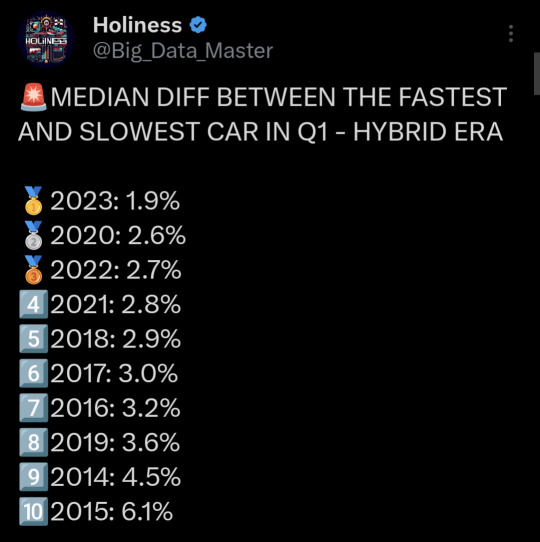
Which is the 4th most poles (he's tied with lewis) by a driver in a season
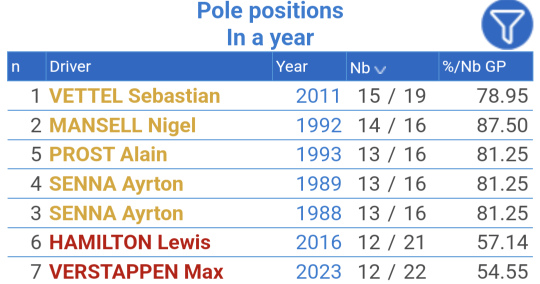
#stop disrespecting his one lap speed 🤨#i hope redbull at least bulid a quali car in the next regs when they fk up their powertrain#max verstappen
10 notes
·
View notes
Text
Wtf is this rumour 💀

#i wouldn't say this could be real cuz I don't expect de Vries to be going to a mahindra powertrain or Daruvala to be going to Maserati tbf#nor Edo to Mahindra but rather to Abt#racing#formula e#silly season 10
20 notes
·
View notes
Text
im uncomfortable w the visibility of this blog tbh i might start posting more of the personal stuff on the degenerate sports blog
#me switching my primary url every few years <- normal behaviour#its funny bc i met sam irl two weeks back and sam was like i will still think of you as rhu powertrains#and i mean yeah im still a little bit rhu powertrains in my heart#its partly bc all of the asks im getting now its either like weird racists / or anons who i have to do like a few months of research for#so i feel like i need a serious / personal separation
10 notes
·
View notes
Text

Cute❤️ via @bradleyscanes Instagram
#max verstappen#red bull racing#maxwdc2021#bradley scanes#physiobrad#redbull formula 1 team#red bull f1#oracle red bull racing#red bull#red bull powertrains
70 notes
·
View notes
Text
You no what is funny? It’s always all Max fans who are racist, or homophobic, or misogynistic and Max NEEDS to address this! Needs to call all his fans out. But if it’s the other way around and TeamLH is shit it’s just one individual and not the whole fan base. “It was just one tweet” I read so many tweets calling Hannah out and being just bad in general. But for them it was just one person and it wasn’t needed that the whole team was called out. It is just so stupid so hypocritical I’m just lost for words.
#hannah schmitz#max verstappen#red bull racing#red bull powertrains#oracle red bull racing#teamlh (derogatory)
82 notes
·
View notes
Text
EV Energy Management Systems (EVEMS)
March 1, 2024
by dorleco
with no comment
Control Systems

Introduction
Sales of electric automobiles are rising. By the end of 2021, there will be over 16.5 million electric vehicles on the road worldwide, which is quadruple the number from 2018.
EVs also bring with them an increasing electricity demand. According to the 2020 International Energy Agency’s Global EV Outlook, during periods of peak demand, the percentage of electricity used for EV charging might reach as high as 4–10% by 2030.
However, the majority of cars—EVs included—are parked for approximately 95% of the time. In addition, there are times during the day when the peak demand for power varies dramatically, resulting in periods of unused production capacity.
Managing electrical capacity when maintaining charging stations has become more difficult as electric vehicles have grown in popularity in Canada, particularly in multi-use residential and commercial buildings.
Although a lot of companies are installing EV charging stations to accommodate their clients, employees, and tenants, there’s a chance that the whole load will surpass the energy capacity. EV energy management systems (EVEMS) can help with it.
Challenges to the widespread adoption of EVs
1. Inadequate infrastructure for charging

The broad adoption of electric vehicles is severely hampered by the inadequate infrastructure for charging them. This is especially true in less developed or rural locations, where there are fewer charging stations, deterring drivers from switching to electric cars.
Range anxiety is also brought on by a lack of charging infrastructure, since drivers may worry that they won’t be able to locate a charging station when traveling long distances.
2. Overloaded electrical grids
The possibility of grid overloading is another obstacle to the widespread use of electric vehicles. The demand for power rises as more and more electric vehicles are connected to the grid, increasing the risk of grid overloading at times of peak demand.
This can therefore lead to problems such as blackouts and other problems that could harm the electricity system’s dependability.
3. Insufficient availability of vital minerals
The insufficient availability of vital minerals and rare earth metals required for electric vehicle infrastructure is a significant obstacle to the extensive integration of electric vehicles.
These minerals are needed to produce EV batteries and other necessary parts. However as the number of EVs on the road rises, demand for certain minerals is rising quickly, and the supply of these minerals is restricted globally.
This might cause problems for EV producers in the supply chain and increase their costs, which would hinder the uptake of electric vehicles.
How smart Energy Management System can help overcome these challenges?
This is how smart EV energy management systems can help one overcome the above challenges.
1. Utilize charging infrastructure effectively
By making efficient use of the current infrastructure, smart energy management systems might potentially address the issue of insufficient charging infrastructure.
These systems can maximize charging station utilization while minimizing their impact on the power grid by analyzing energy consumption, renewable energy generation, and energy costs.

This can facilitate the mass adoption of electric vehicles by reducing the need for costly infrastructure upgrades and improving the accessibility and dependability of the charging infrastructure.
To further improve the effectiveness of the charging infrastructure, electric vehicle drivers can also receive real-time information about the location and availability of charging stations by using mobile apps and EV energy management software.
2. Load balancing to prevent excessive load on the grid
Potentially, smart energy management technologies can help with grid overload issues. By coordinating the charging of loads to occur during off-peak hours, when there is less power demand, these sophisticated systems can distribute the load on the grid.
Smart energy management systems can increase grid stability and dependability by employing this technique to keep the grid from suffering extra demand during peak times.
Moreover, by utilizing energy produced during off-peak hours, when renewable sources like solar and wind power are more plentiful, this technique can maximize the usage of renewable energy sources.
Battery monitoring and recycling to reduce the carbon footprint of EVs To reduce the carbon footprint of electric vehicles (EVs), battery recycling and surveillance are essential.
By gathering vital information on battery health and consumption statistics, intelligent energy management systems may dramatically maximize the efficiency of electric vehicle batteries.
Moreover, intelligent energy management systems can guarantee that batteries are properly recycled at the end of their useful lives, reducing the environmental impact of electric vehicles.
This entails decreasing the need for mining, recovering vital components and rare earth metals required in battery production, and lowering the carbon footprint associated with battery production.
3. For EVs, why should you choose a smart Energy Management System app?
An intelligent energy management app for electric vehicles (EVs) maximizes energy use, which lowers costs and boosts sustainability and efficiency.
It enables EV owners to control several energy-related aspects of their cars, such as battery consumption and charging duration.
4. Detailed user analytics
One of the main advantages of the smart EV app for energy management is the availability of thorough data. Analyzing and tracking a user’s energy consumption patterns can be made easier with the help of a smart EV energy management system.
In turn, this can help owners of electric vehicles (EVs) identify inefficient locations and make data-driven choices to maximize their energy use.
EV owners can obtain a thorough insight into their energy consumption, charging history, and driving trends by applying extensive user statistics, like those offered by the Tesla application.
Furthermore, tailored suggestions can be provided to enhance energy efficiency, such as cutting back on energy use during peak hours and timing charging to prevent needless energy loss.
By putting these suggestions into practice, the EV’s range may be increased and driving enjoyment may be enhanced overall.

5. Cost savings
An intelligent EV energy management system can help owners of electric vehicles (EVs) reduce their charging costs and hence improve their overall cost-effectiveness by maximizing energy use.
As an example, a powerful EV smart energy management system may identify charging infrastructure inefficiencies and continuously monitor charging operations in real time.
This information can help EV owners minimize energy loss and associated costs by helping them make informed decisions about when and how to charge their cars.
6. Improved experience for users
EVs offer several advantages for energy management, including better user experience. Developing a strong EV energy management system can greatly improve the experience for the final user.
First off, owners of electric vehicles can monitor and control their charging sessions with ease thanks to the user-friendly interface provided by EV energy management software, which increases convenience and flexibility.
For example, the EV energy management software can provide customized charging schedules according to the user’s driving habits and preferences, making charging smooth and enjoyable.
EV owners may also make informed decisions about their energy usage and its ecological impact by using the EV energy management system, which can offer them insights into their energy consumption and carbon footprint.
7. Enhances synchronization
A robust energy management platform designed for electric vehicles (EVs) can improve communication between power grids, EV drivers, and the charging infrastructure.
With the help of the EV smart energy management application, drivers of electric vehicles may plan the most efficient routes and steer clear of needless detours by accessing real-time information about the availability and status of charging stations.
Additionally, by enabling two-way communication between EV drivers and power grids, the EV energy management program can improve the synchronization of energy supply and demand.
The program ensures that electricity demands stay balanced and maintains grid stability by adjusting the billing rate based on the available capacity of the grid.
Additionally, by encouraging EV drivers to charge their cars during off-peak hours, the EV energy management platform can help reduce peak demand, ease grid stress, and lessen the chance of blackouts.
8. Reduction in consumption of essential elements
An intelligent energy management app for electric vehicle owners can optimize their energy usage and offer tools to prolong the life of the battery and check its condition.
The energy management software for EVs monitors temperature, charging habits, and battery usage to help identify potential problems and make recommendations for enhancing battery performance.
As a result, the software can aid in lowering the need for new EV batteries as well as the amount of rare earth materials needed to produce them.
The EV energy management system can also offer information on battery recycling and disposal, which is essential for minimizing environmental effects.
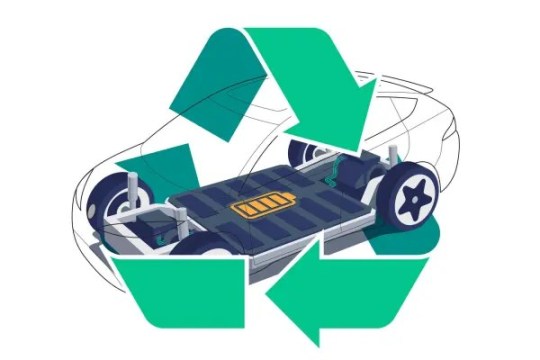
Factors to consider while implementing an effective smart Energy Management System
Have an awareness of the current state
Integration and interoperability
Choosing the right hardware and software
Scalability
Managing cyber risk
Conclusion:
The importance, difficulties, and potential applications of electric vehicle (EV) energy management systems (EMS) would be summarized as follows:
An important step forward in the integration of electric vehicles into our transportation infrastructure is the use of electric vehicle energy management systems.

These technologies are essential for maximizing energy efficiency, enhancing car performance, and guaranteeing effective charging procedures.
Electricity flow between the grid, EVs, and charging stations is intelligently managed by EMS, which improves user experience while simultaneously supporting the sustainability and stability of the power system.
The requirement for standardization and interoperability among the many parts and stakeholders in the EV ecosystem is one of the main issues facing EV EMS.
For EMS to be widely used and effective, it must be possible for various charging networks, car manufacturers, and energy providers to communicate and work together seamlessly.
Furthermore, EMS has both opportunities and challenges as a result of the quick development of EV technology and the breakthroughs made in renewable energy sources.
Adding projections for renewable energy supply, dynamic pricing models and changes in grid demand to EMS algorithms can improve their flexibility and effectiveness.
Looking ahead, to overcome these obstacles and realize the full potential of EV Energy Management Systems, more research and development work will be required.
Innovation, standardization, and scalability of EMS solutions will be driven by collaboration between industry actors, governments, and researchers.
In the end, the broad implementation of EMS promises to maximize the advantages of electric mobility while lowering greenhouse gas emissions and reliance on fossil fuels, creating a more robust and sustainable transportation system.
#EMS#VCU#Powertrains#EVEMS#EVCharging#Dorleco#ADAS#Electricmotor#EVs#Hybridelectricvehicles#Electrigenerator
0 notes
Note
liam??? my child??? sorry danny hope you enjoy the remaining opportunities you'll get this year but if liam won't get the seat next year i'll be toto wolff's better version and will truly report red bull racing honda powertrains or something like that and alpha tauri honda or however they'll be called next year to the fia and every governing body
i don't remember doing a line and ghost writing in my own inbox but here we are.
#RED BULL RACING HONDA POWERTRAINS#gurrll we red bull racing honda floptrains watt fucking power#okay okay BUT i said this to my friend two days ago and she was like Mmm but that would be realistically unlikely bc promoted to rbr after#3 races etc etc and i was like mmm yeah etc etc but tumblr dot com is where we thrive and we do not thrive on UNLIKELIES and REALISTICS#x: asks#asks: ll40#singapore 23#god bless eight time winners but the little pink helmet kiwi is where im at#anon my beloved#EMPHASIS ON BELOVED
7 notes
·
View notes
Text



nothing like a chestappen podium 🥇🥈
#f1#formula 1#formula one#red bull racing#red bull#max verstappen#redbull racing#red bull honda#red bull f1#red bull team#sergio pérez#sergio checo pérez#sergio perez#checo perez#redbull f1#red bull formula 1#red bull powertrains#japanese gp#japan gp 2024#japanese gp 2024#japan grand prix#suzuka gp 2024#chestappen#perstappen
64 notes
·
View notes